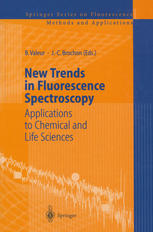

Most ebook files are in PDF format, so you can easily read them using various software such as Foxit Reader or directly on the Google Chrome browser.
Some ebook files are released by publishers in other formats such as .awz, .mobi, .epub, .fb2, etc. You may need to install specific software to read these formats on mobile/PC, such as Calibre.
Please read the tutorial at this link: https://ebookbell.com/faq
We offer FREE conversion to the popular formats you request; however, this may take some time. Therefore, right after payment, please email us, and we will try to provide the service as quickly as possible.
For some exceptional file formats or broken links (if any), please refrain from opening any disputes. Instead, email us first, and we will try to assist within a maximum of 6 hours.
EbookBell Team

0.0
0 reviewsFluorescence is more and more widely used as a tool of investigation, analysis, control and diagnosis in many fields relevant to physical, chemical, biological and medical sciences. New technologies con tinuously emerge thanks to the progress in the design of light sources (e.g. laser diodes), detectors (3D, 4D) and compact ultrafast elec tronic devices. In particular, much progress has been made in time resolved fluorescence microscopy (FUM: Fluorescence Lifetime Imaging Microscopy; FCS: Fluorescence Correlation Spectroscopy). Furthermore, the sensitivity now allows one to detect a single mole cule in the restricted field of a confocal microscope, which actually offers the possibility to study phenomena at a molecular level. The development of new fluorescent probes is still a necessity. In particular, the growing use of lasers implies high resistance to photo degradation. Fluorescence emission at long wavelengths is also a distinct advantage. Furthermore, in vivo inclusion of new fluorescent aromatic residues in proteins offer new potentialities in biology. of ions and molecules is Fluorescence-based selective detection still the object of special attention. Considerable effort is being made in the design of supramolecular systems in which the recognition event is converted into a fluorescence signal easily detected. New fluorescent sensors for clinical diagnosis and detection of pollutants in atmosphere and water are extensively developed. All these developments justify the regular publication of books giving the state-of-the-art of the methods and applications of fluo rescence spectroscopy.